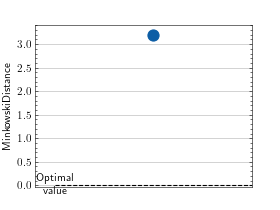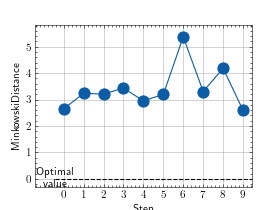Minkowski Distance¶
Module Interface¶
- class torchmetrics.MinkowskiDistance(p, **kwargs)[source]¶
Compute Minkowski Distance.
\[d_{\text{Minkowski}} = \sum_{i}^N (| y_i - \hat{y_i} |^p)^\frac{1}{p}\]- where
- math:
y is a tensor of target values,
- math:
hat{y} is a tensor of predictions,
- math:
p is a non-negative integer or floating-point number
This metric can be seen as generalized version of the standard euclidean distance which corresponds to minkowski distance with p=2.
- Parameters:
p¶ (
float) – int or float larger than 1, exponent to which the difference between preds and target is to be raisedkwargs¶ (
Any) – Additional keyword arguments, see Advanced metric settings for more info.
Example
>>> from torchmetrics.regression import MinkowskiDistance >>> target = tensor([1.0, 2.8, 3.5, 4.5]) >>> preds = tensor([6.1, 2.11, 3.1, 5.6]) >>> minkowski_distance = MinkowskiDistance(3) >>> minkowski_distance(preds, target) tensor(5.1220)
- plot(val=None, ax=None)[source]¶
Plot a single or multiple values from the metric.
- Parameters:
val¶ (
Union[Tensor,Sequence[Tensor],None]) – Either a single result from calling metric.forward or metric.compute or a list of these results. If no value is provided, will automatically call metric.compute and plot that result.ax¶ (
Optional[Axes]) – An matplotlib axis object. If provided will add plot to that axis
- Return type:
- Returns:
Figure and Axes object
- Raises:
ModuleNotFoundError – If matplotlib is not installed
>>> from torch import randn >>> # Example plotting a single value >>> from torchmetrics.regression import MinkowskiDistance >>> metric = MinkowskiDistance(p=3) >>> metric.update(randn(10,), randn(10,)) >>> fig_, ax_ = metric.plot()

>>> from torch import randn >>> # Example plotting multiple values >>> from torchmetrics.regression import MinkowskiDistance >>> metric = MinkowskiDistance(p=3) >>> values = [] >>> for _ in range(10): ... values.append(metric(randn(10,), randn(10,))) >>> fig, ax = metric.plot(values)

Functional Interface¶
- torchmetrics.functional.minkowski_distance(preds, targets, p)[source]¶
Compute the Minkowski distance.
\[\begin{split}d_{\text{Minkowski}} = \\sum_{i}^N (| y_i - \\hat{y_i} |^p)^\frac{1}{p}\end{split}\]This metric can be seen as generalized version of the standard euclidean distance which corresponds to minkowski distance with p=2.
- Parameters:
- Return type:
- Returns:
Tensor with the Minkowski distance
Example
>>> from torchmetrics.functional.regression import minkowski_distance >>> x = torch.tensor([1.0, 2.8, 3.5, 4.5]) >>> y = torch.tensor([6.1, 2.11, 3.1, 5.6]) >>> minkowski_distance(x, y, p=3) tensor(5.1220)
